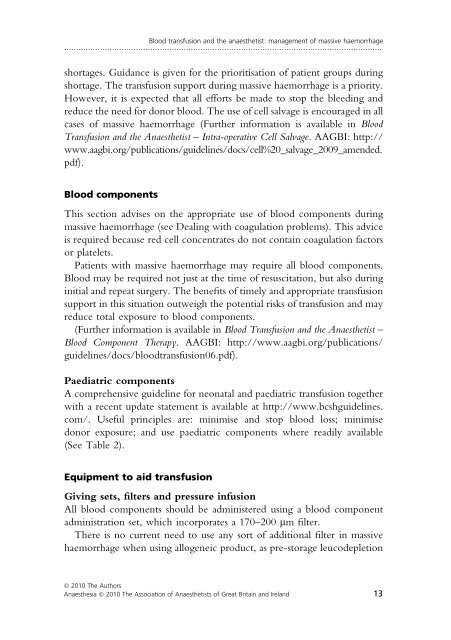Blood transfusion and the anaesthetist: management of ... - aagbi
Blood transfusion and the anaesthetist: management of ... - aagbi
Blood transfusion and the anaesthetist: management of ... - aagbi
Create successful ePaper yourself
Turn your PDF publications into a flip-book with our unique Google optimized e-Paper software.
<strong>Blood</strong> <strong>transfusion</strong> <strong>and</strong> <strong>the</strong> anaes<strong>the</strong>tist: <strong>management</strong> <strong>of</strong> massive haemorrhage<br />
.....................................................................................................................................<br />
shortages. Guidance is given for <strong>the</strong> prioritisation <strong>of</strong> patient groups during<br />
shortage. The <strong>transfusion</strong> support during massive haemorrhage is a priority.<br />
However, it is expected that all efforts be made to stop <strong>the</strong> bleeding <strong>and</strong><br />
reduce <strong>the</strong> need for donor blood. The use <strong>of</strong> cell salvage is encouraged in all<br />
cases <strong>of</strong> massive haemorrhage (Fur<strong>the</strong>r information is available in <strong>Blood</strong><br />
Transfusion <strong>and</strong> <strong>the</strong> Anaes<strong>the</strong>tist – Intra-operative Cell Salvage. AAGBI: http://<br />
www.<strong>aagbi</strong>.org/publications/guidelines/docs/cell%20_salvage_2009_amended.<br />
pdf).<br />
<strong>Blood</strong> components<br />
This section advises on <strong>the</strong> appropriate use <strong>of</strong> blood components during<br />
massive haemorrhage (see Dealing with coagulation problems). This advice<br />
is required because red cell concentrates do not contain coagulation factors<br />
or platelets.<br />
Patients with massive haemorrhage may require all blood components.<br />
<strong>Blood</strong> may be required not just at <strong>the</strong> time <strong>of</strong> resuscitation, but also during<br />
initial <strong>and</strong> repeat surgery. The benefits <strong>of</strong> timely <strong>and</strong> appropriate <strong>transfusion</strong><br />
support in this situation outweigh <strong>the</strong> potential risks <strong>of</strong> <strong>transfusion</strong> <strong>and</strong> may<br />
reduce total exposure to blood components.<br />
(Fur<strong>the</strong>r information is available in <strong>Blood</strong> Transfusion <strong>and</strong> <strong>the</strong> Anaes<strong>the</strong>tist –<br />
<strong>Blood</strong> Component Therapy. AAGBI: http://www.<strong>aagbi</strong>.org/publications/<br />
guidelines/docs/blood<strong>transfusion</strong>06.pdf).<br />
Paediatric components<br />
A comprehensive guideline for neonatal <strong>and</strong> paediatric <strong>transfusion</strong> toge<strong>the</strong>r<br />
with a recent update statement is available at http://www.bcshguidelines.<br />
com/. Useful principles are: minimise <strong>and</strong> stop blood loss; minimise<br />
donor exposure; <strong>and</strong> use paediatric components where readily available<br />
(See Table 2).<br />
Equipment to aid <strong>transfusion</strong><br />
Giving sets, filters <strong>and</strong> pressure infusion<br />
All blood components should be administered using a blood component<br />
administration set, which incorporates a 170–200 lm filter.<br />
There is no current need to use any sort <strong>of</strong> additional filter in massive<br />
haemorrhage when using allogeneic product, as pre-storage leucodepletion<br />
Ó 2010 The Authors<br />
Anaes<strong>the</strong>sia Ó 2010 The Association <strong>of</strong> Anaes<strong>the</strong>tists <strong>of</strong> Great Britain <strong>and</strong> Irel<strong>and</strong> 13

















